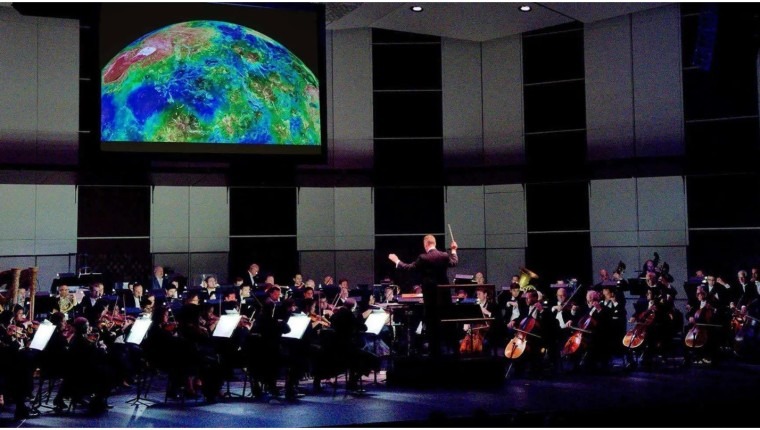Percussion, Planets and
Thinking Back to the Beginning
. . .
Boy, am I feeling old. The opening of every music season takes me yet another year from my very first Florida Orchestra concert, when the musicians kicked off the 1981-’82 season. They were known as the Florida Gulf Coast Symphony back then, and Irwin Hoffman stood at the podium in the University of Tampa’s old and creaky McKay Auditorium.
That was 42 years ago − a half century according to my bones − and I remember the night. . . Dvorak’s Carnival Overture, Schubert’s Symphony No. 5, and after intermission, Tchaikovsky’s Symphony No. 3. Two symphonies on one bill? You didn’t argue with Hoffman.
So, this past weekend, my wife and I settled into seats at St. Pete’s Mahaffey Theater for the latest opener, this time with a guy named Michael Francis leading a lot of young faces. Among them were a few vets from back in the day, including violinist Valerie Adams and cellist Lowell Adams, both of whom joined the orchestra that same year so long ago.
Much has changed since then, and the 2023-24 season offers something more – “Mystery Pieces’’ – short works that aren’t announced in advance, but performed as a surprise, much like an encore at a piano recital.
“I want to mix up the programs, so that’s the purpose of the Mystery Pieces,’’ Francis tells me. “I want our programs to be engaging and uplifting and delightful – I don’t want them to be medicine. So, it’s a way to enhance the concert experience and make you smile.’’
Saturday evening opened in percussive fashion with Drum Circles by the Texas-born composer Christopher Theofanidis, who gave us his engaging Symphony No. 1 three years ago.
Theofanidis came onstage to describe the piece, which he wrote specifically for the Percussion Collective, a group of virtuoso musicians based in Ithaca NY, and making their first appearance with TFO.
The work requires a cornucopia of instruments – xylophones, Chinese cymbals, bongos, guiro, marimba, glockenspiel, double-headed tom-tom, amplified typewriter, wooden slats, and spring coils.
The opening Rivers and Anthem jolts listeners with clamoring chimes and multiple melodies cascading over each other like a turbulent musical river. Sparks and Chants follows at a mystical pace, lush strings blending with the tangy resonance of marimbas.
The central section, How Can You Smile When You’re Deep in Thought serves as a short scherzo, piqued by the quirky sound of a typewriter and toy bells. Then comes Spirits and Drums, a persistent circle of drumming reminiscent of an ancient ritual.
The work ends with Three Chords and the Truth, mixing country and blues themes before resigning on a quietly lyrical note.
The soloists returned for an encore – Astor Piazzolla’s Grand Tango, transcribed from the original duet for cello and piano.
Then came our first Mystery Piece, Two Eastern Pictures by Gustav Holst, featuring the women of the Master Chorale of Tampa Bay, Anna Kate Mackle on harp and John Shaw on tambourine.
These short works – Spring and Summer – reflect the composer’s “Indian Period,’’ and the writings of the great 5th-century Indian poet and dramatist Kalidasa. The choir caressed these ethereal poems as the audience followed the English translations of the Sanskrit projected overhead.
Projections certainly grabbed the audience’s attention through Holst’s masterpiece The Planets, with NASA images synchronized to the composer’s nuanced but fearless rhythmic blueprint.
If some object to pairing visuals with what essentially is an abstract plan (it was inspired by astrology, not astronomy) the Mahaffey audience loved it, applauding after each movement.
“There’s just a powerful juxtaposition of the different sections, especially between Venus and Mars,’’ Francis says. “And it was an absolutely radical piece of orchestration for its time and utterly modern in its language.’’

The suite begins with the gripping Mars, the Bringer of War, its menacing ostinato in 5/4 time evolving into brassy barbarism, the strings playing col legno (with the wood of the bow). Venus, the Bringer of Peace followed in relaxed contrast, and handed the baton to the quicksilver Mercury, the Winged Messenger.
The most famous section, Jupiter, the Bringer of Jollity, is an extroverted celebration by the entire orchestra, and sets up the solemn Saturn, the Bringer of Old Age, and the macabre march of spent souls in Uranus, the Magician.
A cellphone interrupted the show at this point, but Francis – always prepared for musical triage − spun around at the podium and exclaimed, “at least it sounds spacey.’’
The night ended with Neptune, the Mystic, its disembodied, offstage women’s chorus singing a wordless hymn, never rising above pianissimo, and evaporating into silence.
Originally published in the Florida Orchestra Blog



